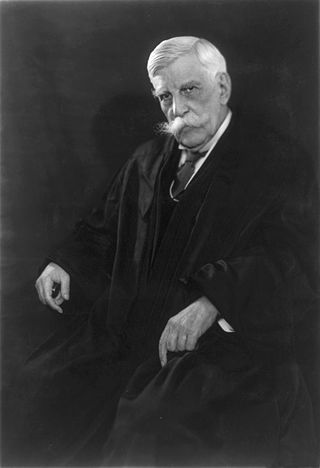
Clear and present danger was a doctrine adopted by the Supreme Court of the United States to determine under what circumstances limits can be placed on First Amendment freedoms of speech, press, or assembly. The test was replaced in 1969 with Brandenburg v. Ohio's "imminent lawless action" test.

James Biddle, of the Biddle family, brother of financier Nicholas Biddle and nephew of Capt. Nicholas Biddle, was an American commodore. His flagship was USS Columbus.
Whitney v. California, 274 U.S. 357 (1927), was a United States Supreme Court decision upholding the conviction of an individual who had engaged in speech that raised a threat to society. Whitney was explicitly overruled by Brandenburg v. Ohio in 1969.

Francis Beverley Biddle was an American lawyer and judge who was the United States Attorney General during World War II. He also served as the primary American judge during the postwar Nuremberg Trials as well as a United States circuit judge of the Court of Appeals for the Third Circuit.
Buck v. Bell, 274 U.S. 200 (1927), is a decision of the United States Supreme Court, written by Justice Oliver Wendell Holmes, Jr., in which the Court ruled that a state statute permitting compulsory sterilization of the unfit, including the intellectually disabled, "for the protection and health of the state" did not violate the Due Process Clause of the Fourteenth Amendment to the United States Constitution. Despite the changing attitudes in the coming decades regarding sterilization, the Supreme Court has never expressly overturned Buck v. Bell. It is widely believed to have been weakened by Skinner v. Oklahoma, 316 U.S. 535 (1942), which involved compulsory sterilization of male habitual criminals. Legal scholar and Holmes biographer G. Edward White, in fact, wrote, "the Supreme Court has distinguished the case [Buck v. Bell] out of existence". In addition, federal statutes, including the Rehabilitation Act of 1973 and the Americans with Disabilities Act of 1990, provide protections for people with disabilities, defined as both physical and mental impairments.
"Imminent lawless action" is one of several legal standards American courts use to determine whether certain speech is protected under the First Amendment of the United States Constitution. The standard was first established in 1969 in the United States Supreme Court case Brandenburg v. Ohio.

Masses Publishing Co. v. Patten, 244 F. 535, was a decision by the United States District Court for the Southern District of New York, that addressed advocacy of illegal activity under the First Amendment.
Albertson v. Subversive Activities Control Board, 382 U.S. 70 (1965), was a case in which the Supreme Court of the United States ruled on November 15, 1965, that persons believed to be members of the Communist Party of the United States of America could not be required to register as party members with the Subversive Activities Control Board because the information which party members were required to submit could form the basis of their prosecution for being party members, which is a crime, and therefore deprived them of their self-incrimination rights under the Fifth Amendment to the United States Constitution.
Keystone Bituminous Coal Ass'n v. DeBenedictis, 480 U.S. 470 (1987), is a United States Supreme Court case interpreting the Fifth Amendment's Takings Clause. In this case, the court upheld a Pennsylvania statute which limited coal mining causing damage to buildings, dwellings, and cemeteries through subsidence.

The United States Court for China was a United States district court that had extraterritorial jurisdiction over U.S. citizens in China. It existed from 1906 to 1943 and had jurisdiction in civil and criminal matters, with appeals taken to the U.S. Court of Appeals for the Ninth Circuit in San Francisco.
Kunz v. New York, 340 U.S. 290 (1951), was a United States Supreme Court case finding a requirement mandating a permit to speak on religious issues in public was unconstitutional. It was argued October 17, 1950, and decided January 15, 1951, 8–1. Chief Justice Vinson delivered the opinion for the Court. Justice Black and Justice Frankfurter concurred in the result only. Justice Jackson dissented.

Noyes Slough is a secondary channel of the Chena River contained entirely within the city limits of Fairbanks, Alaska. It is approximately 7 miles (11 km) long and separates the Garden Island district of Fairbanks from the rest of the town. During the summer, the slough is used by canoeists and waterfowl. In the winter, the slough freezes and is used by cross-country skiers, snowshoers, and mushers. It forms part of the route for the annual Open North American Sled Dog Championship and the Iron Dog snowmobile race, each of which end in downtown Fairbanks.
Rancho Las Mariposas was a 44,387-acre (179.63 km2) Mexican land grant in Alta California, located in present-day Mariposa County, California.
Green v. Biddle, 1 U.S. 1 (1823), is a 6-to-1 ruling by the Supreme Court of the United States that held that the state of Virginia had properly entered into a compact with the United States federal government under Clause One of Article Four of the United States Constitution. This compact surrendered Virginia's claim to the area that eventually became the state of Kentucky, but imposed restrictions on Kentucky's ability to upset title to land sold or otherwise granted by the state of Virginia at the time of the compact. The Supreme Court held that legislation enacted by Kentucky that restricted these rights unconstitutionally infringed on Virginia's right to surrender the land in accordance with Article Four, Clause One.
Fiske v. Kansas, 274 U.S. 380 (1927), was a United States Supreme Court Case that was first argued May 3, 1926 and finally decided May 16, 1927.
Hess v. Indiana, 414 U.S. 105 (1973), was a United States Supreme Court case involving the First Amendment that reaffirmed and clarified the imminent lawless action test first articulated in Brandenburg v. Ohio (1969). Hess is still cited by courts to protect speech threatening future lawless action.
United States v. Lee, 274 U.S. 559 (1927), is a significant decision by the United States Supreme Court protecting prohibition laws. The Court held 1) the Coast Guard may seize, board, and search vessels beyond the U.S. territorial waters and the high seas 12 miles outward from the coast if probable cause exists to believe that the vessel and persons in it are violating U.S. revenue laws, and 2) the Coast Guard's use of searchlights to view contents of a vessel on the high seas does not constitute a search and thus does not warrant Fourth Amendment protections.
The president of the United States is authorized by the U.S. Constitution to grant a pardon for a federal crime. The other forms of the clemency power of the president are commutation of sentence, remission of fine or restitution, and reprieve. A person may decide not to accept a pardon, in which case it does not take effect, according to a Supreme Court majority opinion in Burdick v. United States. In 2021, the 10th Circuit ruled that acceptance of a pardon does not constitute a legal confession of guilt, recognizing the Supreme Court's earlier language as dicta.
United States v. Sullivan, 274 U.S. 259 (1927), is a United States Supreme Court case that allowed prosecution of criminals for income tax evasion notwithstanding the Fifth Amendment.






